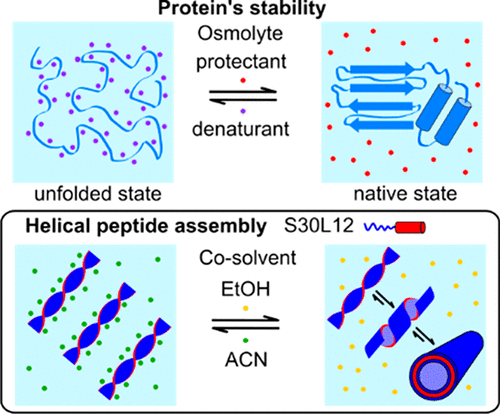当前位置:
X-MOL 学术
›
J. Am. Chem. Soc.
›
论文详情
Our official English website, www.x-mol.net, welcomes your
feedback! (Note: you will need to create a separate account there.)
Solvent Effects on the Self-Assembly of an Amphiphilic Polypeptide Incorporating α-Helical Hydrophobic Blocks
Journal of the American Chemical Society ( IF 14.4 ) Pub Date : 2020-12-04 , DOI: 10.1021/jacs.0c03425 Avanashiappan Nandakumar 1 , Yoshihiro Ito 1, 2 , Motoki Ueda 1, 2
Journal of the American Chemical Society ( IF 14.4 ) Pub Date : 2020-12-04 , DOI: 10.1021/jacs.0c03425 Avanashiappan Nandakumar 1 , Yoshihiro Ito 1, 2 , Motoki Ueda 1, 2
Affiliation

|
The self-assembly of biological molecules is an important pathway to understanding the molecular basis of complex metabolic events. The presence of a cosolvent in an aqueous solution during the self-assembly process can promote the formation of kinetically trapped metastable intermediates. In nature, a category of cosolvents termed osmolytes can work to strengthen the hydrogen-bond network of water such that the native states of certain proteins are favored, thus modulating their function and stability. However, identifying cosolvents that act as osmolytes in biomimetic applications, such as the self-assembly of soft materials, remains challenging. The present work examined the effects of ethanol (EtOH) and acetonitrile (ACN) as cosolvents on the self-assembly of the amphiphilic polypeptide PSar30-(l-Leu-Aib)6 (S30L12), which incorporates α-helical hydrophobic blocks, in aqueous solution. The results provided a direct observation of morphological behavior of S30L12 as a function of solvent composition. Morphological transitions were investigated using transmission electron microscopy, while the packing of peptide molecules was assessed using circular dichroism analyses and evaluations of membrane fluidity. In the EtOH/H2O mixtures, the EtOH strengthened the hydrogen-bond network of the water, thus limiting the hydrophobic hydration of S30L12 assemblies and enhancing hydrophobic interactions between assemblies. In contrast, ACN formed self-associated nanoclusters in water and at the hydrophobic cores of peptide assemblies to stabilize the edges exposed to bulk water and enhance the assembly kinetics. Fourier transform infrared (FT-IR) analysis indicated that both EtOH and ACN can modify the self-assembly of biomaterials in the same manner as osmolyte protectants or denaturants.
中文翻译:

溶剂对包含 α-螺旋疏水块的两亲性多肽自组装的影响
生物分子的自组装是理解复杂代谢事件分子基础的重要途径。在自组装过程中,水溶液中存在助溶剂可以促进动力学捕获的亚稳态中间体的形成。在自然界中,一类称为渗透剂的助溶剂可以加强水的氢键网络,从而有利于某些蛋白质的天然状态,从而调节它们的功能和稳定性。然而,识别在仿生应用(例如软材料的自组装)中充当渗透剂的助溶剂仍然具有挑战性。目前的工作检查了乙醇 (EtOH) 和乙腈 (ACN) 作为共溶剂对两亲性多肽 Psar30-(l-Leu-Aib)6 (S30L12) 自组装的影响,它在水溶液中结合了α-螺旋疏水嵌段。结果提供了对作为溶剂组成函数的 S30L12 形态行为的直接观察。使用透射电子显微镜研究形态转变,而使用圆二色性分析和膜流动性评估评估肽分子的堆积。在 EtOH/H2O 混合物中,EtOH 加强了水的氢键网络,从而限制了 S30L12 组件的疏水水合并增强了组件之间的疏水相互作用。相比之下,ACN 在水中和肽组装体的疏水核心处形成自缔合纳米团簇,以稳定暴露于大量水的边缘并增强组装动力学。
更新日期:2020-12-04
中文翻译:

溶剂对包含 α-螺旋疏水块的两亲性多肽自组装的影响
生物分子的自组装是理解复杂代谢事件分子基础的重要途径。在自组装过程中,水溶液中存在助溶剂可以促进动力学捕获的亚稳态中间体的形成。在自然界中,一类称为渗透剂的助溶剂可以加强水的氢键网络,从而有利于某些蛋白质的天然状态,从而调节它们的功能和稳定性。然而,识别在仿生应用(例如软材料的自组装)中充当渗透剂的助溶剂仍然具有挑战性。目前的工作检查了乙醇 (EtOH) 和乙腈 (ACN) 作为共溶剂对两亲性多肽 Psar30-(l-Leu-Aib)6 (S30L12) 自组装的影响,它在水溶液中结合了α-螺旋疏水嵌段。结果提供了对作为溶剂组成函数的 S30L12 形态行为的直接观察。使用透射电子显微镜研究形态转变,而使用圆二色性分析和膜流动性评估评估肽分子的堆积。在 EtOH/H2O 混合物中,EtOH 加强了水的氢键网络,从而限制了 S30L12 组件的疏水水合并增强了组件之间的疏水相互作用。相比之下,ACN 在水中和肽组装体的疏水核心处形成自缔合纳米团簇,以稳定暴露于大量水的边缘并增强组装动力学。











































 京公网安备 11010802027423号
京公网安备 11010802027423号